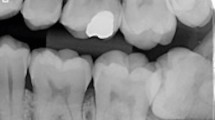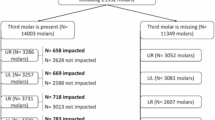Key Points
-
MAU methodology allows assessments of both medical and non-medical factors including outcomes of removal and retention of mandibular third molars.
-
Patients' ranking of preferred outcomes was similar, regardless of country.
-
Patients prefer outcomes of third molar non-removal as compared to outcomes following removal.
-
Patient treatment preferences are more stable across national boundaries than dentist preferences.
Abstract
Aim To elucidate and compare patients' outcome preferences for removal and retention of mandibular third molars in Sweden and Wales.
Subjects and method The subjects comprised patients referred and scheduled for removal of one or both mandibular third molars in Sweden and Wales. The multi-attribute utility (MAU) methodology was applied to study patients' preferences for outcomes of removal and retention of the mandibular third molar.
Results Relative weighting of domains was similar in the two countries. 'Home and social life' received the highest relative weighting in Sweden and 'general health and wellbeing' in Wales. 'Your appearance' received the lowest relative weighting in both countries. In both Sweden and Wales operative jaw fracture was considered to be the outcome with most impact and dentigerous cyst and imbricated incisors the least impact. Outcome ranking was similar in both countries and operative outcomes were considered by patients to be more detrimental to health than retention outcomes.
Conclusions This comparison showed that patients' preferences in Sweden and Wales were similar and that the outcomes of surgery were considered worse after third molar removal than retention. Patient-orientated treatment decisions were less subject to variation than clinician-orientated decisions.
Similar content being viewed by others
Log in or create a free account to read this content
Gain free access to this article, as well as selected content from this journal and more on nature.com
or
References
Sackett DL, Rosenberg WM, Gray JA, et al. Evidence based medicine: what it is and what it isn't. Br Med J 1996; 312: 71–72.
Keeny R, Raiffa H . Decisions with multiple objectives: preferences and value trade-offs. New York: John Wiley, 1976.
Torrance GW, Boyle MH, Horwood SP . Application of multiattribute utility theory to measure social preferences for health states. Oper Res 1982; 30: 1043–1069.
Knutsson K, Brehmer B, Lysell L, et al. General dental practitioners' evaluation of the need for extraction of asymptomatic mandibular third molars. Community Dent Oral Epidemiol 1992; 20: 347–350.
Knutsson K, Brehmer B, Lysell L, et al. Asymptomatic mandibular third molars: oral surgeonsÂ' judgement of the need for extraction. J Oral Maxillofac Surg 1992; 50: 329–333.
Brickley M, Kay E, Shepherd JP, et al. Decision analysis for lower-third-molar surgery. Med Decis Making 1995; 15: 143–151.
Armstrong RA, Brickley MR, Evans DJ et al. Patient perceptions regarding the risks of complications of lower third molar removal. Community Dent Health 1996; 13: 17–21.
Liedholm R, Knutsson K, Lysell L, et al. The outcomes of mandibular third molar removal and non-removal: a study of patients' preferences using a multi-attribute method. Acta Odontol Scand 2000; 58: 293–298.
Worrall SF, Riden K, Haskell R, et al. UK National third molar project: the initial report. Br J Oral Maxillofac Surg 1998; 36: 14–18.
Babbie E . The practice of social research. 6th ed. Belmont (Ca): Wadsworth Publishing Company, 1992.
Brickley M, Armstrong R, Shepherd J, et al. The relevance of health state utilities to lower third molar surgery. Int Dent J 1995; 45: 124–128.
Van Gool A V, Ten Bosch J J, Boering G . Clinical consequences of complaints and complications after removal of the mandibular third molar. Int J Oral Surg 1977; 6: 29–37.
Nordenram Å . Postoperative complications in oral surgery. A study of cases treated during 1980. Swed Dent J 1983; 7: 109–113.
Osborn TP, Frederickson G Jr, Small IA, et al. A prospective study of complications related to mandibular third molar surgery. J Oral Maxillofac Surg 1985; 43: 767–769.
Sisk AL, Hammer WB, Shelton DW, et al. Complications following removal of impacted third molars: the role of the experience of the surgeon. J Oral Maxillofac Surg 1986; 44: 855–859.
Mercier P, Precious D . Risks and benefits of removal of impacted third molars. J Oral Maxillofac Surg 1992; 21: 17–27.
Stanley HR, Alattar M, Collett WK, et al. Pathological sequelae of 'neglected' impacted third molars. J Oral Pathol 1988; 17: 113–117.
Eliasson S, Heimdal A, Nordenram Å . Pathological changes related to long-term impaction of third molars. A radiographic study. Int J Oral Maxillofac Surg 1989; 18: 210–212.
Von Wowern N, Nielsen H O . The fate of impacted lower third molars after the age of 20. A four-year clinical follow-up. Int J Oral Maxillofac Surg 1989; 18: 277–280.
Ahlqwist M, Gröndahl HG . Prevalence of impacted teeth and associated pathology in middle-aged and older Swedish women. Community Dent Oral Epidemiol 1991; 19: 116–119.
Boyle MH, Torrance GW . Developing multiattribute health indexes. Med Care 1984; 22: 1045–1057.
Liedholm R, Knutsson K, Lysell L, et al. Mandibular third molars: oral surgeons' assessment of the indications for removal. Br J Oral Maxillofac Surg 1999; 37: 440–443.
Knutsson K, Lysell L, Rohlin M, et al. Comparison of decisions regarding prophylactic removal of mandibular third molars in Sweden and Wales. Br Dent J 2001; 190: 198–202.
Author information
Authors and Affiliations
Corresponding author
Additional information
Refereed paper
Rights and permissions
About this article
Cite this article
Liedholm, R., Knutsson, K., Lysell, L. et al. Third molar treatment outcome: a comparison of patients' preferences in Sweden and Wales. Br Dent J 199, 287–291 (2005). https://doi.org/10.1038/sj.bdj.4812653
Accepted:
Published:
Issue date:
DOI: https://doi.org/10.1038/sj.bdj.4812653
This article is cited by
-
Incidence of symptoms in previously symptom-free impacted lower third molars assessed in general dental practice
British Dental Journal (2009)
-
Address the real cause
British Dental Journal (2006)
-
What do patients think of impacted wisdom teeth treatment?
British Dental Journal (2005)



